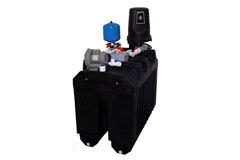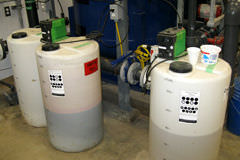Water Chlorination
What is Water Chlorination?
Chlorination of water is a method mostly used for disinfection by adding hydrochloride or chlorine to water.
Water can contain very dangerous microorganisms that can cause illnesses such as jaundice, cholera, typhoid fever, dysentery, and gastroenteritis.
The chlorination process will eliminate such pathogens from water.
Water chlorination can be used to oxidize iron, cyanide and manganese to ease the filtration process.
It is also used for odor control in water or wastewater.
Water Chlorination
Get rid of unpleasant odors, turbidity and harmful water borne bacteria.
What are the benefits of Water Chlorination?
Chlorination can keep water free of harmful bacteria such as E-coli, Heterotrophic bacteria and Coliform bacteria.
Chlorinating water will get rid of unpleasant odors, turbidity and can also prevent the transmission of disease.
Chlorination systems are cost effective and easy to maintain.

Dry Chlorination

Liquid Chlorination
Instructions for chlorinating a water well
Before proceeding, bypass all water treatment equipment including softeners, iron-filters, and any drinking water equipment. Failure to do so will irreparably damage the equipment in question.
Chlorinating a well involves not using water for 24 hours. Saving water for cooking and drinking is essential; alternate accommodations are recommended as well.
In a large tank, pour 4-5 gallons (16-20) liters of white vinegar. This will lower the pH of the well water, stimulating better oxidation.
Fill two 5-gallon pails with about 4 gallons of hot tap water in each pail. To each pail, add 1.5-2 lbs of 65% granular chlorine (sodium hypochlorite) powder. Stir this mixture until the powder is completely dissolved, then pour each pail into the large tank. Do not stand over the mouth of the tank, as the chlorine will react with the vinegar, and create harmful vapor.
Fill the tank with well water. Depending on your pump, and the well's recovery rate, this may take some time.
Run a hose from the tank into the well casing. Run another hose (the one used to fill the tank works well). Turn on the second hose, and leave it on - this will keep your pump running. Open the drain valve from the tank, and allow water to flow into the well.
Do not open the drain all the way. Monitor the drain output, matching it to the well's output. If this is not monitored closely, damage to the well can result.
When the tank is empty, close the drain valve. Allow the hose (form the well) to run, and check for chlorine odor. If the water from the hose smells like bleach, turn of the supply valve to it.
Run all the cold taps in the house, until each one smells of chlorine. Flush toilets 3-4 times to ensure that chlorinated water is in the water closets (tanks). Run your washing machine and dishwasher through a normal cycle. Include outside taps, watering bowls (livestock barns etc.), and 'outdoor' installations as well.
Run all the hot water sources in the same fashion as above. When taps and all other services smells of chlorine, the water system is 'dosed' with chlorine and oxidation can begin.
Allow the chlorine to sit in the water system for 24 hours.
Starting with the tap used to fill the tank, run the well out (to a septic field, drain or other containment) until the water runs clear and has no chlorine smell or taste. This may take some time.
Run all cold taps, inside and out, including livestock facilities, outdoor service, etc. until the water is free of chlorine smell and taste.
Repeat the above step for all hot water outlets.
When the water is completely free of chlorine smell and taste, turn on the supply to any water treatment equipment that is installed.
The entire process may have to be repeated if iron bacteria is a recurring problem.
Contact:
George Hogg
WTC
Email:
info@waterbygeorge.ca
Cell:
780 871 9283
Phone:
780 809 2256
Postal Address:
PO Box 12699
Lloydminster, AB T9V 0Y4
